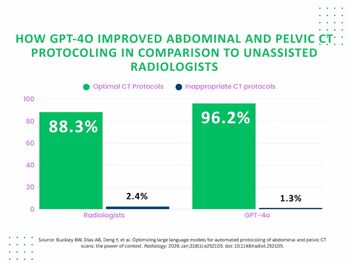
Hitachi primes 1.2T Oasis for commercial launch
Hitachi executives hope their booth at the ISMRM meeting will serve as a springboard for sales of their open 1.2T Oasis, set to begin shipping this month. The new high-field scanner is the company’s chance to rekindle a market that has all but collapsed in the past several years with the advent of compact wide-bore 1.5T devices and expanding clinical applications for such high-performance systems.
Hitachi executives hope their booth at the ISMRM meeting will serve as a springboard for sales of their open 1.2T Oasis, set to begin shipping this month. The new high-field scanner is the company's chance to rekindle a market that has all but collapsed in the past several years with the advent of compact wide-bore 1.5T devices and expanding clinical applications for such high-performance systems.
The Japanese company made its name in the MR market a decade ago with the release of its wildly successful line of low-field open scanners. In their heyday, these scanners accounted for about 40% of new MR sales in the U.S., but the flood of demand has slowed to a trickle in recent years.
With a list price of about $1.5 million, Oasis is within reach of the 1500 or so facilities operating Hitachi's now aging installed base of low-field open scanners. But most of the interest so far has come from hospitals, according to Sheldon I. Schaffer, vice president and general manager for Hitachi MR and CT.
"Our first few installations will be going into hospitals that range from 75 beds to 650 beds," Schaffer said.
Oasis offers the kind of productivity and range of applications typically achieved with cylindrical high-field scanners, he said, yet does so through a novel design that creates an unusually open venue by offsetting the two poles that support the dual disks of the superconducting magnet.
The gradient system generates 33 mT/m amplitude and 100 T/m/sec slew rate. Active shielding contains the vertical magnetic fringe field within the space typically occupied by a 1.5T field.
In developing the new product, company engineers applied technologies developed for the Hitachi 1.5T Echelon, a closed cylindrical high-field product. Among the shared features are many of the electronics built into 1.5T, as well as the software. Commonalties between the two allow Hitachi to migrate features on the Echelon, such as a pulse sequence for dynamic abdominal and bilateral breast studies and a noncontrast MR angiography protocol for visualizing the peripheral vasculature, to the Oasis.
Newsletter
Stay at the forefront of radiology with the Diagnostic Imaging newsletter, delivering the latest news, clinical insights, and imaging advancements for today’s radiologists.




























